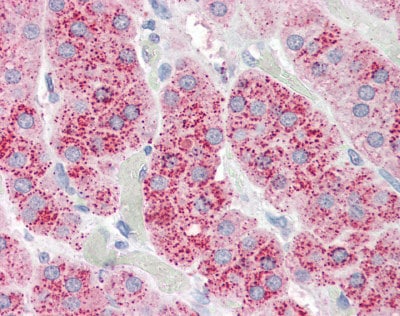Anti-Wnt3 antibody (ab116222)
Key features and details
- Goat polyclonal to Wnt3
- Suitable for: WB, IHC-P
- Reacts with: Human
- Isotype: IgG
Overview
-
Product name
Anti-Wnt3 antibody
See all Wnt3 primary antibodies -
Description
Goat polyclonal to Wnt3 -
Host species
Goat -
Tested applications
Suitable for: WB, IHC-Pmore details -
Species reactivity
Reacts with: Human
Predicted to work with: Mouse, Rat, Chicken, Dog, Xenopus laevis, Zebrafish
-
Immunogen
Synthetic peptide:
CGRGHNTRTEKRKEK
, corresponding to C terminal amino acids 315-329 of Human Wnt3. -
Positive control
- WB: Human brain lysate IHC-P: Human adrenal, breast and thyroid tissues
Properties
-
Form
Liquid -
Storage instructions
Shipped at 4°C. Upon delivery aliquot and store at -20°C. Avoid repeated freeze / thaw cycles. -
Storage buffer
pH: 7.30
Preservative: 0.02% Sodium azide
Constituents: 99% Tris buffered saline, 0.5% BSA -
 Concentration information loading...
Concentration information loading... -
Purity
Immunogen affinity purified -
Clonality
Polyclonal -
Isotype
IgG -
Research areas
Images
-
Anti-Wnt3 antibody (ab116222) at 1 µg/ml + Human brain lysate (in RIPA buffer) at 35 µg
Developed using the ECL technique.
Predicted band size: 40 kDa
Exposure time: 1 hour
-
 Immunohistochemistry (Formalin/PFA-fixed paraffin-embedded sections) - Anti-Wnt3 antibody (ab116222)ab116222, at 3.75 µg/ml, staining Wnt3 in formalin fixed, paraffin embedded Human adrenal tissue by Immunohistochemistry. After incubation with the primary antibody, slides were incubated with anti-goat IgG biotinylated secondary antibody, followed by alkaline phosphatase-streptavidin and chromogen.
Immunohistochemistry (Formalin/PFA-fixed paraffin-embedded sections) - Anti-Wnt3 antibody (ab116222)ab116222, at 3.75 µg/ml, staining Wnt3 in formalin fixed, paraffin embedded Human adrenal tissue by Immunohistochemistry. After incubation with the primary antibody, slides were incubated with anti-goat IgG biotinylated secondary antibody, followed by alkaline phosphatase-streptavidin and chromogen. -
 Immunohistochemistry (Formalin/PFA-fixed paraffin-embedded sections) - Anti-Wnt3 antibody (ab116222)ab116222, at 3.75 µg/ml, staining Wnt3 in formalin fixed, paraffin embedded Human breast tissue by Immunohistochemistry. After incubation with the primary antibody, slides were incubated with anti-goat IgG biotinylated secondary antibody, followed by alkaline phosphatase-streptavidin and chromogen.
Immunohistochemistry (Formalin/PFA-fixed paraffin-embedded sections) - Anti-Wnt3 antibody (ab116222)ab116222, at 3.75 µg/ml, staining Wnt3 in formalin fixed, paraffin embedded Human breast tissue by Immunohistochemistry. After incubation with the primary antibody, slides were incubated with anti-goat IgG biotinylated secondary antibody, followed by alkaline phosphatase-streptavidin and chromogen. -
 Immunohistochemistry (Formalin/PFA-fixed paraffin-embedded sections) - Anti-Wnt3 antibody (ab116222)ab116222, at 3.75 µg/ml, staining Wnt3 in formalin fixed, paraffin embedded Human thyroid tissue by Immunohistochemistry. After incubation with the primary antibody, slides were incubated with anti-goat IgG biotinylated secondary antibody, followed by alkaline phosphatase-streptavidin and chromogen.
Immunohistochemistry (Formalin/PFA-fixed paraffin-embedded sections) - Anti-Wnt3 antibody (ab116222)ab116222, at 3.75 µg/ml, staining Wnt3 in formalin fixed, paraffin embedded Human thyroid tissue by Immunohistochemistry. After incubation with the primary antibody, slides were incubated with anti-goat IgG biotinylated secondary antibody, followed by alkaline phosphatase-streptavidin and chromogen.












